|
04.03.09
EP Pre-production - Tools
TAPE MACHINES
The heart of our recording setup is the tape machine - an MCI JH-110C 8 track. While we've railed on about this thing before, it's served us pretty well since we've gotten it. The thing to keep in mind with this and other analog tape machines that are around is that they're almost all several decades old. While this machine is meant to be serviced and parts for it don't take too much trouble to source, bits and pieces still fail from time to time, making the final recording a bit of a challenge. Still, the sound quality and the reliability of analog tape make it worth the trouble.
Once the signals is printed onto the 8 track, we'll mix it down onto our MCI JH-110C 2 track, using 1/2" tape. While there are fancier machines out there for this job, it's nice to have the same technology to learn between machines. If things to really bad, we can swap some parts between machines. Let's hope nothing gets that bad.
OUTBOARD UNITS
Before the tape machine, the sound will be picked up from the instruments by microphones, which are then routed into the "pre"s (preamplifiers, preamps, mic pre). I often wondered what these things were for before getting one. Actually, the name preamplifier is a bit misleading; a mic pre actually amplifies the electrical signal produced by the microphone (or, in the case of microphones that need phantom power, produced by the microphone and preamplifier together). Different pres exhibits different characteristics with different microphones. The three we have - a Hamptone HJFP2 , a Sytek MPX 4Aii and an FMR RNP - are all well built mid range preamps that have different sounds to them. These options allow us to choose a type of sound that may be more appropriate for a particular instrument. We will compare different preamps on different signals later on.
From there we may just run the signal into the tape machine. Our options for processing the signal are minimal, which is how we want it. If we don't go directly from the preamp to the tape machine, we may delay a signal slightly, compress it (limiting the difference between the soft and the loud parts) or blend it with another signal. The pictures of the racks over to the right show some of the things we have to allow us to do that. The patchbays are where everything meets together - all of the ins and outs of each of these things (tape machines, mixing board, effects units, mic pres, etc.) all plug into the patchbays. This makes it very easy to connect things to one another - rather than get behind everything and switch long cables back and forth, the patchbays allow us to quickly plug things into different places, keeping work nice and orderly.
MIXING BOARD
Grand Central Station for all of this stuff is the mixing board - an Allen and Heath "Mixwizard" 20:8:2. While this is firmly planted in the "pro-sumer" range of products, it's worked remarkably well for us. A&H sold these things in the 90's for people starting to record on Alesis's shitty ADAT format, a digital format that was popular at the time and has since proven to be unreliable. The good news is that each ADAT machine was an 8 track, and so this mixer was designed to handle pretty much everything an 8 track would throw at it. All 8 channels have inserts, all main channels have 100mm faders (meaning that the neat-o sliders that are the first thing everyone monkeys with have lots of room to go up and down), each channel is modular - if a channel breaks it can be removed and repaired separately from the others.
Best of all, you can record, monitor and playback all of the 8 channels at different levels while recording without having to change any levels. So, if Thad is recording bass, we can blend two channels from the board to one channel on the tape machine at one ratio, play that blend back into his headphones at another level ("turn the bass up in the mix so that I can hear what I'm playing") and play it at a different level in the monitors for Justin to hear.
Considering that we bought the thing over a dozen years ago and it's given us almost zero problems while offering sufficient flexibility, we're very happy with it.
ETC.
Given the limited number of tracks on the tape machine, we often have to make decisions before we hit record on the tape machine. We can't, for example, print six different mics each recording the same guitar onto six different tracks and then decide what to keep when it comes time to mixdown. This is fine - it requires discipline that will keep the process of recording moving along. But to help decide which options are best, we will demo a song using the computer to record. This will help us make the decisions we need so that we'll know what's best to print to the final tape. As you'll see, we'll review options, listen to which sounds best and note the final decision. If this is not clear, please be a little patient with us. It'll be obvious once we start doing it (next post).
We'll cover the microphones as we use them because, well, this post is too long as it is.
|
|  |
 |
 |

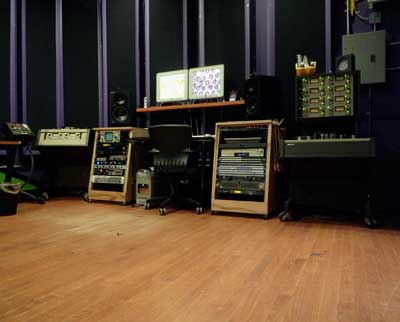
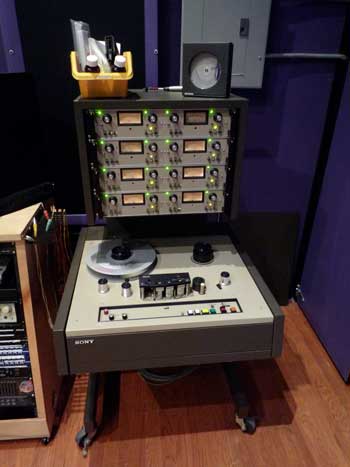
Yet another picture of the MCI JH-110C 8 track. You can count the tracks by counting the meters. Neat, eh?
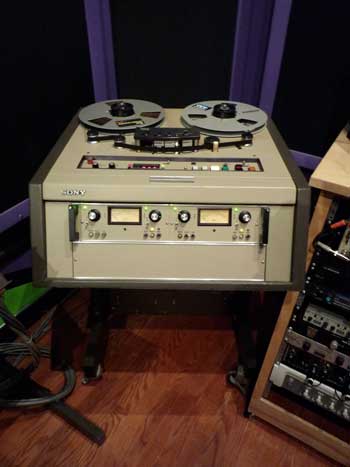
The mixdown deck - MCI JH-110C 2 track set up for 1/2" tape.
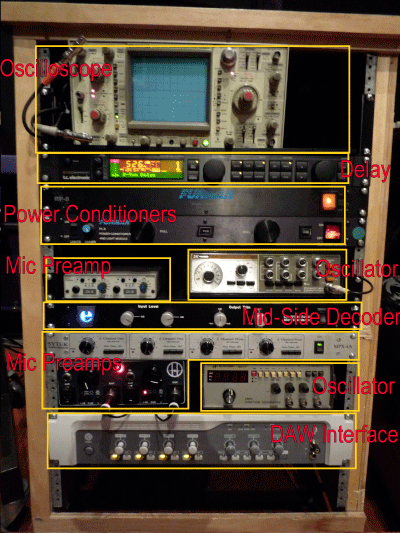
Left side of the rack. Most of the knob twiddling happens over here.
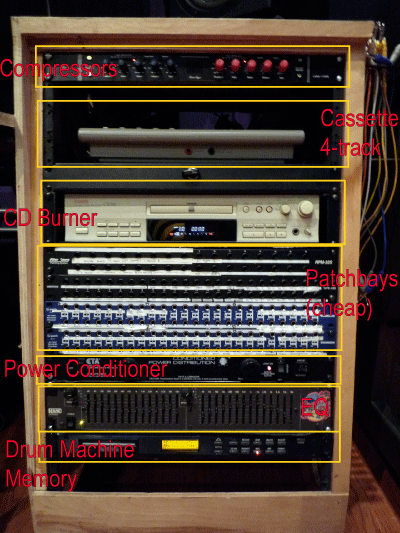
Right side of the rack. The patchbay gets most of the action while we're recording. Check out the ancient Alesis Datadisk on the bottom that's still humming along. That thing's pretty tough.
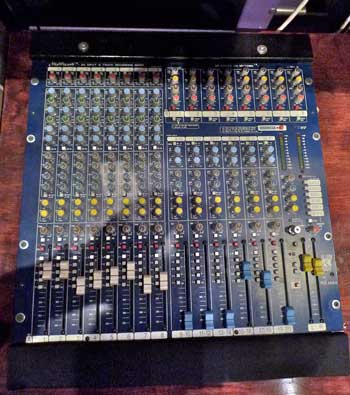
So here's the mixing board. Humble, but it has served us well for about 15 years.

The board from the bottom. Justin counted 58 audio plugs while taking this picture. We NEVER use the inserts, so we just bought the cheap-o Hosa snake for that.

|
 |
 |
 |
[ LATEST UPDATE ]
[ Archives ]
CONSTRUCTION
[ Overview ]
[ Basic Construction ]
[ Acoustics ]
[ HVAC ]
[ Electrical ]
[ The Grand Vision ]
[ Tool Reviews ]
[ Links and Resources ]
|